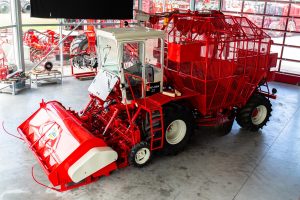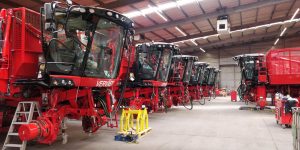Dutch company Vervaet is definitely the reference in Europe for slurry and manure processing or beet harvesting. The company alternately produces beet harvesters and manure trikes in its plant in Biervliet, depending on the seasons.
How it all started
 The story of Vervaet started in 1957, when Frans and Richard Vervaet, the sons of agricultural contractor Jef Vervaet and his wife Madeleine, decided to set up their own company. “They repaired and serviced anything with an engine, from fridges and motorcycles to cars and even tractors”, according to the company. As a result of the explosive growth of mechanisation during this period, there was a lot of demand for their services. In 1958, the brothers became Nuffield Tractors dealers. The customer base and the company expanded and by 1960, they moved into new premises in Biervliet. In time, Vervaet also became a dealer for Simca and McCormick, forcing the company to expand again in 1961.
The story of Vervaet started in 1957, when Frans and Richard Vervaet, the sons of agricultural contractor Jef Vervaet and his wife Madeleine, decided to set up their own company. “They repaired and serviced anything with an engine, from fridges and motorcycles to cars and even tractors”, according to the company. As a result of the explosive growth of mechanisation during this period, there was a lot of demand for their services. In 1958, the brothers became Nuffield Tractors dealers. The customer base and the company expanded and by 1960, they moved into new premises in Biervliet. In time, Vervaet also became a dealer for Simca and McCormick, forcing the company to expand again in 1961.
To ensure the company’s continuity and growth, the brothers acquired several other companies in the early seventies. Vervaet switched from McCormick to John Deere and the rest is history.
Own production
By this time, several of Vervaet’s ten children had joined his contracting business. In those days, Walter and Marcel Vervaet needed a self-propelled machine to harvest sugar beets, which is why they started thinking about how to develop such a machine.
In 1974, Frans, Richard, Tonnie, Walter, and Marcel Vervaet joined forces. Together they built a self-propelled one-phase bunker harvester for sugar beets based on the principle of the combine harvester: a header for harvesting at the front with a large bunker at the rear. During the very wet fall of 1974, the new machine proved its worth: it was able to continue operating thanks to its large, simultaneously driven wheels, whereas tractor-drawn harvesters got stuck in the mud. Thanks to the machine, the topping, harvesting and transport could be done by one person. A real revolution compared with the traditional two- or even three-phase harvesting process. The concept of a self-propelled beet harvester proved far from popular, however, and Vervaet ended up investing a lot of energy in convincing people of the concept’s merits. The development of the machine did not go as seamlessly as they had hoped either.
Four years after the construction of the first bunker harvester, the Vervaet family made a second attempt to build a new, improved machine, partnering with Heyens (of Hulst, the Netherlands). Heyens came up with a concept without a topper, but with a better harvesting system. It was a success. The machine performed well in the field and garnered a lot of interest. While the bunker harvester was more expensive than traditional machines, it was also more cost-efficient to use.
After a few years, the first machines were traded in for new ones and the used ones were rebuild and adapted in line with the newest techniques. As they were technically new, they were resold, under warranty. An approach that would prove highly lucrative.
By the early eighties, the first hydraulic drive systems were fitted on machines and the operator’s comfort was significantly improved thanks to the modern Claas cabs.
Hydro Trike
To give Robin and Edwin, the second generation who were raring to join the company, the space they needed to operate and further professionalise the company’s operations, Vervaet was split into three entities in 1987: a Mazda car dealership, a John Deere agricultural machinery dealership, and the production of self-propelled beet harvesters. Two years later, Robin and Edwin joined the family business. In 1990, the two brothers developed a three-wheeled vehicle for slurry injection, together with Dany Dieleman, anticipating on the new legislation that would ban the aboveground application of slurry. The Hydro Trike was born. In the early nineties, a factory was built in Biervliet for the production of these new machines. By 1992, the company produced 15 Hydro Trikes a year, in addition to the same number of beet harvesters.
As a result of the enormous potential of these machines and growing demand, Vervaet tapped into new international markets, including the UK, Belgium, France, Sweden, and Denmark. Production flourished and soon the existing plant had to be expanded again.
17T beet harvesters
Soon competition increased thanks to new machine launches. The demand for a larger machine with a greater bunker capacity, larger wheels and better cleaning of the beets grew. In 1993, Vervaet struck back with the prototype of the 17T beet harvester. The new concept was such a success that the decision was made to increase production from 13 to 25 harvesters the following year.
Vervaet 2000
In 1999, Vervaet took full control of the production. To achieve this, the plant had to be expanded and the company needed to hire more employees.
Beat Eater and Hydro Trike for XXL
Vervaet was the first company to launch a six-row harvester, as well as the first company to launch a nine-row concept in the 2000s, called the Beat Eater. During this period, the demand for harvesters that could compact the soil evenly increased. The company believed that the only way to achieve this was to develop a nine-row machine, to increase capacity, without increasing the speed too much. The Beat Eater was a huge success in the small beet harvester market. Five machines rolled off the line every year.
The concept of the Hydro Trike XXL was revised, with an additional tank behind the existing trike, increasing the total capacity to 24m3.
Vervaet today
 A new decade brought new expansion. By 2010, the agricultural machine division operated out of three plants. A new warehouse, showroom and storage shed were added to the premises in Biervliet. One division that is becoming increasingly important at a modern company such as Vervaet is R&D, which continually monitors the market to develop new variants. All the development is purposefully done in-house.
A new decade brought new expansion. By 2010, the agricultural machine division operated out of three plants. A new warehouse, showroom and storage shed were added to the premises in Biervliet. One division that is becoming increasingly important at a modern company such as Vervaet is R&D, which continually monitors the market to develop new variants. All the development is purposefully done in-house.
Since then, the company also developed an umbilical version of the Hydro Trike. This self-propelled slurry injector with a draghose has several advantages, including higher capacity, one wide wheel per track and it can easily turn on the headland, while the pump continues to operate on the suction side. The international market for this machine (Germany, France, Italy, and the UK) became increasingly important. In 2016, the first self-propelled trikes for vinasse were supplied to the French market. These machines can spread small amounts across large widths and can achieve extremely high speeds in the field: up to 35 km/h. The Hydro Trike Universal Spreader was updated and adapted to meet the requirements of the French and British markets, respectively.
At the same time, Vervaet continued to work on the development of its beet harvesters: in 2010, the Beat Eater 617 and 625 won awards at BeetEurope. Six years later, the company designed a new type of beet harvester, called the Q Series. The Q616 is a light-weight vehicle with a 16-ton bunker, whereas the Q621 is heavier because of its 21-tonne bunker.
Third generation
Since then, the third generation has joined the family business. The company premises cover a surface area of 50,000 sqm. of which 13,500 is built up. Ten percent of the turnover goes to R&D and the company produces 75 to 100 new self-propelled machines every year.
What originally started out as a small family business soon became a leading player on the international agricultural market.
Text: Kim Schoukens
Images: Antoon Vanderstraeten & Tom Goovaerts
This article appeared in Farmers of Europe Magazine nbr. 1.
Click here to read the magazine (free).





